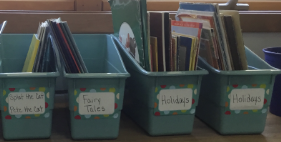Children who are routinely read to day in and day out—and immersed in rich talk about books and the various activities in which they are engaged—thrive. And those children with less exposure to books face tougher learning challenges in school and beyond (Campbell et al., 2002; Dickinson, McCabe, & Essex, 2006; Neuman & Celano, 2006)
Wallet-Friendly Ways to Obtain Books
Exposure to print in and out of the classroom is vital to a child’s success. With ever tightening school budgets, it can be difficult to obtain books for your classroom. Many teachers resort to purchasing books with their own money. There are other wallet-friendly ways to obtain books however!
- Tap into local resources. Many local organizations are willing to donate smaller amounts of money. Be specific yet creative in your proposal.
- Some states offer a Title I grant. For example, the Wisconsin Title I Association offers a yearly innovation grant for programs created to foster literacy in children’s lives.
- Reading is Fundamental offers a list of possible grant sources.
- Scholastic’s James Patterson grant offers mega points and a $500 bonus for classroom libraries.
- Social media is a way to raise funds via websites such as https://www.donorschoose.org/.
Your Classroom Environment
Experiences and interactions with text are also very important for our young readers. Ensuring your classroom is a literacy rich environment is key to student success.
- Create an inviting space for reading – have special reading chairs, comfortable floor pillows, etc.
 Have books that are easily accessible to students. You can find good deals on bookshelves at garage sales and thrift stores. Sort the books by level and by interest (animals, weather, space, etc.)
Have books that are easily accessible to students. You can find good deals on bookshelves at garage sales and thrift stores. Sort the books by level and by interest (animals, weather, space, etc.) - Using big books, model what it looks like to interact with text. Point to words as you read them, model your thinking, model fluent reading.
- Have charts and visuals around the room that help students with how to use books appropriately and to show what good readers do.
Family and community involvement can seem daunting, however, it is possible!
- Know your community. Do you live in a very rural community? Think about creating a bookmobile that can have scheduled stops on certain days for students to exchange books. Do you have a variety of cultures living within district boundaries? Seek to better understand the various cultural values and literacy experiences that may exist.
- Share tips and tricks with parents. Teach parents simple rhyming and sound manipulation games. Help them to make these games fun! Have them encourage t
 heir children to reenact a favorite book, draw about the book. Share with parents simple questions they can ask their child about what they are reading. Model for parents how to help their child interact with different texts. Share the importance of sight words and encourage parents to help their child use pictures to help tell the story.
heir children to reenact a favorite book, draw about the book. Share with parents simple questions they can ask their child about what they are reading. Model for parents how to help their child interact with different texts. Share the importance of sight words and encourage parents to help their child use pictures to help tell the story. - Encourage parents to read aloud to their child!
References:
International Literacy Association. (2018). What’s hot in literacy report. Newark, DE.
Dickinson, David K., et al. “Speaking Out for Language: Why Language Is Central to Reading Development.” Educational Researcher, vol. 39, no. 4, 2010, pp. 305–310. JSTOR, JSTOR, www.jstor.org/stable/27764601.
Neuman, S. B., & Celano, D. (2006). The knowledge gap: Implications of leveling the playing field for low-income and middle-income children. Reading Research Quarterly, 41(2), 176-201. DOI: 10.1598/RRQ.41.2.2
Written by: Katie Hubbard a former district reading specialist who currently serves as the program director for the K-12 Reading/Master of Arts in Literacy Education program at Saint Mary’s University of Minnesota.

Recent Comments